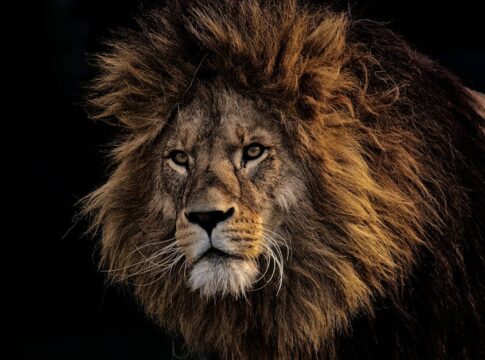⏱️ 5 min read
When moviegoers settle into their seats and the lights dim, one of the most recognizable symbols in cinema history often appears on screen: a majestic lion roaring within a circular frame, surrounded by a ribbon of film. This iconic image has represented Metro-Goldwyn-Mayer (MGM) for nearly a century, but what many don’t realize is that this famous logo wasn’t created through animation or digital effects. The lion featured in MGM’s opening credits was indeed a real, living animal—in fact, several real lions have held this prestigious role throughout the studio’s history.
The Origins of Leo the Lion
The MGM lion made its debut in 1924, shortly after the formation of Metro-Goldwyn-Mayer through a merger of three separate film companies. The studio needed a powerful symbol to represent its brand, and advertising executive Howard Dietz conceived the idea of using a lion accompanied by the Latin motto “Ars Gratia Artis” (Art for Art’s Sake). Dietz drew inspiration from his alma mater, Columbia University, whose athletic teams used a lion as their mascot.
The first lion to appear in the logo was named Slats, who served as MGM’s mascot from 1924 to 1928. Unlike his successors, Slats didn’t roar on screen—he simply looked regally at the camera. This silent but dignified presence set the foundation for what would become one of the most enduring symbols in entertainment history.
Meet the Lions Who Made History
Over the decades, seven different lions have portrayed the MGM mascot, each bringing their own personality to the role. After Slats came Jackie, who became the first MGM lion to roar on screen in 1928. Jackie also holds the distinction of being one of the most well-traveled lions in history, surviving multiple plane crashes and even a boat sinking during various publicity tours.
The most famous of all MGM lions was Leo, who first appeared in 1957 and whose image is still used today. This particular Leo’s roar became synonymous with MGM’s brand identity during Hollywood’s golden age and continues to be featured in modern productions. His recording session required careful planning and the expertise of animal trainers to capture the perfect, commanding roar that audiences know today.
Other Notable Lions in the Legacy
- Tanner: Served as the MGM lion from 1928 to 1932 and appeared in several Technicolor tests
- Coffee: Used briefly in the 1920s as an alternative to the main logo lion
- Telly: Appeared in the logo during the 1920s and 1930s
- George: Featured in the 1950s alongside other lions
- Born Free lion: Occasionally used in the 1960s
The Technical Challenge of Filming a Lion
Creating the iconic roaring lion footage presented significant technical and logistical challenges in the early days of cinema. Filming had to take place in controlled environments with experienced animal handlers present at all times. The lions were trained to look toward the camera and produce their impressive roars on cue, though the audio was often recorded separately and synchronized with the visual footage.
The circular frame surrounding the lion required precise camera work and compositing techniques that were sophisticated for their era. Early versions used hand-painted backgrounds and carefully constructed sets to achieve the desired effect. As technology advanced, the studio refined the logo’s presentation, but the core element—a real lion’s authentic roar—remained constant.
Safety and Animal Welfare Considerations
Working with wild animals in the entertainment industry has always required strict safety protocols and ethical considerations. MGM employed professional animal trainers who specialized in big cats, ensuring both human safety and animal welfare during filming sessions. The lions used for the logo were typically raised in captivity and accustomed to working with human handlers from a young age.
These animals lived in specialized facilities designed to meet their physical and psychological needs. Between filming sessions, they received proper veterinary care, appropriate nutrition, and enrichment activities. Modern standards for animal actors have evolved significantly since the early days of Hollywood, and historical productions must be viewed within their contemporary context.
The Lasting Impact on Brand Recognition
The decision to use a real lion rather than an illustrated or symbolic representation proved to be a masterstroke in branding. The authenticity and power of an actual animal’s roar created an emotional impact that resonated with audiences across generations. This choice established MGM as a studio associated with grandeur, strength, and prestige.
Market research has consistently shown that the MGM lion ranks among the most recognized corporate symbols worldwide, competing with logos from companies far larger and more diverse than a film studio. The logo’s longevity—spanning silent films, talkies, television, and digital streaming—demonstrates the timeless appeal of this authentic imagery.
From Film Reels to Digital Screens
As technology evolved, so did the presentation of the MGM lion, but the studio has carefully preserved the essence of the original footage. Digital restoration techniques have enhanced the clarity and quality of Leo’s roar while maintaining its authentic character. Modern audiences watching MGM productions on streaming platforms still see footage of a real lion, connecting them to nearly a century of cinematic tradition.
The MGM lion serves as a reminder of Hollywood’s golden age, when studios sought to create larger-than-life imagery that would captivate audiences and define their brand identity for generations. In an era of computer-generated imagery and digital effects, the fact that this iconic logo featured real animals adds to its historical significance and enduring charm.

